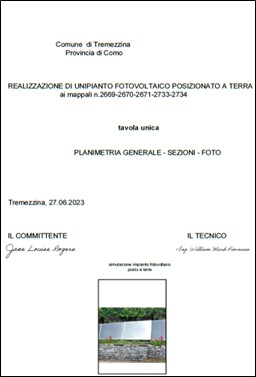AUTHOR: William Mark Piovesan
TUTORS: Ing. Giuliano Dall’O
INTERNSHIP: –
MASTER: Master in “Sustainability and energy management in construction works” a.a 2022/23
La realizzazione di questa tesi ha lo scopo di verificare la fattibilità con le normative del Superbonus 90% 2023, basate sulla riqualificazione energetica di almeno due classi di una abitazione situata in zona climatica, nel rispetto dei vincoli imposti dalla normativa del Superbonus 90%, nei termini di involucro edilizio e di un impianto fotovoltaico.
In particolare, per la realizzazione di questa tesi ho svolto numerosi sopralluoghi presso l’edificio in oggetto onde elaborare la soluzione migliore dove installare l’impianto fotovoltaico, essendo il fabbricato sottoposto a vincolo paesaggistico. La prima soluzione da me esaminata consisteva nell’installazione dell’impianto fotovoltaico sul tetto del fabbricato, cosa che però ho dovuto scartare, in quanto, a seguito dei vincoli paesaggistici l’impianto fotovoltaico si sarebbe potuto installare solo ed esclusivamente se integrato nel tetto dell’edificio; quindi, si sarebbero dovute rimuovere le tegole di una grande superficie del tetto e sostituirle con diverse lamiere grecate sulle quali poi posizionare i pannelli fotovoltaici. Tale soluzione si è rivelata da subito molto onerosa e di difficile realizzazione.
Dopo un’attenta analisi del sito, ho optato invece per una installazione dell’impianto fotovoltaico a terra, fissato al di sopra di un muretto esistente, con la precauzione, sempre per i vincoli paesaggistici, che i pannelli fotovoltaici non avrebbero dovuto essere visibili in alcun modo dalla strada pubblica.
Ho sviluppato l’attestato di prestazione energetica (APE), tramite il software Termolog, necessario alla verifica dei vincoli imposti dalla normativa del Superbonus 90% e necessario a comprendere quali fossero le prestazioni dell’edificio allo stato di fatto, e conseguentemente con le migliorie necessarie per il salto di almeno di due classi.
Il lavoro della tesi è progredito con la scelta di quei componenti che permettessero all’edificio di migliorare la sua qualità energetica e ridurre quindi i consumi, in particolare ho scelto di applicare alle pareti esterne un cappotto termico interno (lana di roccia spessore 50 mm più lastra in cartongesso spessore 15 mm e relativa struttura in lamiera zincata per il fissaggio) onde migliorare la trasmittanza termica e la trasmittanza termica periodica.
L’opera di progettazione si è conclusa con la verifica dei limiti tecnici che permettano alla seguente opera di riqualifica energetica di accedere alla normativa di Superbonus 90%, e la produzione dell’attestato di prestazione energetica dello stato progettuale che certifichi il miglioramento della classe energetica, la riduzione dei consumi, l’aumento della produzione energetica mediante fonte rinnovabile e la richiesta di autorizzazione paesaggistica.
FOR INTERNATIONAL STUDENTS:
The realization of this thesis aims to verify the feasibility with the regulations of the Superbonus 90% 2023, based on the energy requalification of at least two classes of a house located in climate zone, in compliance with the constraints imposed by the regulations of Superbonus 90%, in terms of building envelope and a photovoltaic system.
In particular, for the realization of this thesis I have carried out numerous inspections at the building in question in order to elaborate the best solution where to install the photovoltaic system, being the building subject to landscape constraint. The first solution I examined was the installation of the photovoltaic system on the roof of the building, which I had to discard, because, as a result of the landscape constraints, the photovoltaic system could be installed only and exclusively if integrated into the roof of the building; Therefore, the tiles of a large roof area should have been removed and replaced with different trapezoidal sheets on which to place the photovoltaic panels. This solution was immediately very expensive and difficult to implement.
After a careful analysis of the site, I opted instead for an installation of the photovoltaic system on the ground, fixed above an existing wall, with the precaution, always for landscape constraints, that the photovoltaic panels should not have been visible in any way from the public road.
I developed the energy performance certificate (APE), through the software Termolog, necessary to verify the constraints imposed by the Superbonus 90% and necessary to understand what the performance of the building was in fact, and consequently with the necessary improvements for the jump of at least two classes.
The work of the thesis has progressed with the choice of those components that allowed the building to improve its energy quality and thus reduce consumption, I chose to apply to the external walls an internal thermal coat (rock wool thickness 50 mm plus plasterboard sheet thickness 15 mm and its structure in galvanized sheet for fixing) to improve thermal transmittance and periodic thermal transmittance.
The design work ended with the verification of the technical limits that allow the following work of energy requalification to access the Superbonus 90% standard, and the production of the certificate of energy performance of the design status that certifies the improvement of the energy class, the reduction of consumption, the increase in energy production through renewable sources and the request for landscape authorisation.


